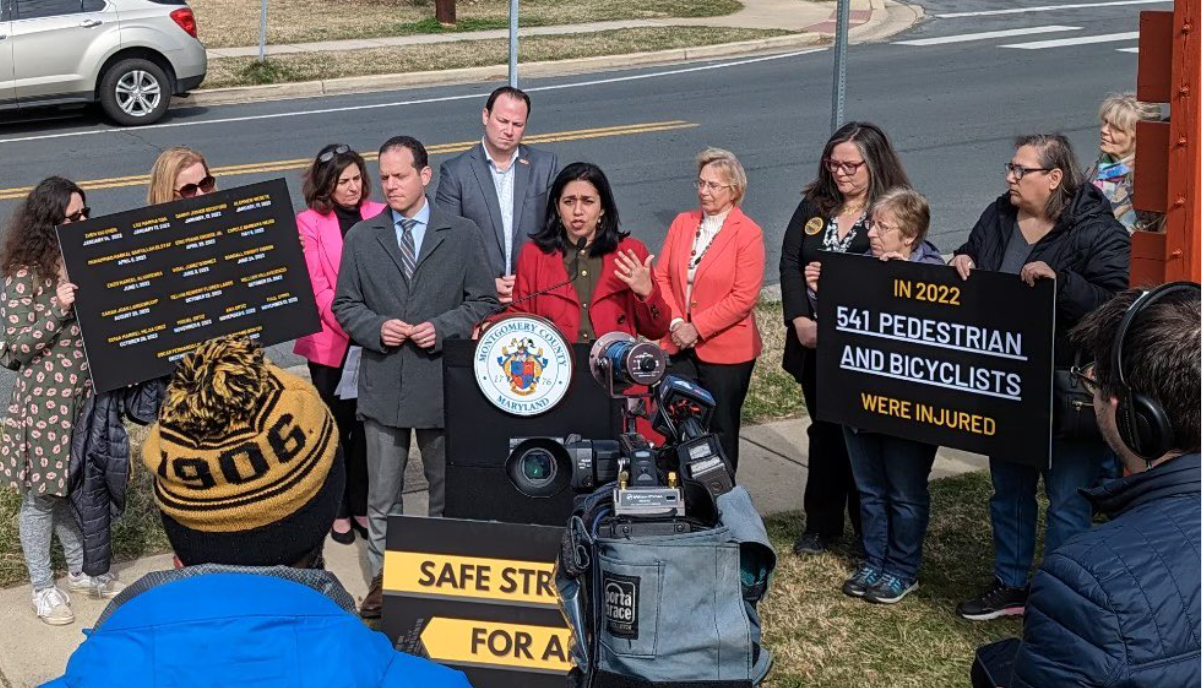By Adam Pagnucco.
Council Members Evan Glass and Will Jawando were the top two vote-getters in the Montgomery County Democratic primary last year. Both are undeniably talented politicians who are looking to move up. But the two may be on a collision course as events this week illustrated.
Consider the bills each introduced on Tuesday.
Glass’s bill, titled The Safe Streets Act of 2023, is a pedestrian and bicyclist safety bill that would do four things. It would require an infrastructure review for pedestrian-related collisions within a school zone. It would prohibit drivers from making right turns on a red light at certain intersections in downtowns and town centers. It would require traffic control devices at crosswalks in downtowns and town centers to give pedestrians extra time to cross. And it would require the county executive to develop an automated traffic enforcement plan that would increase the use of speed cameras, red light cameras and stop sign cameras. The bill is intended to supplement and enhance the county’s Vision Zero plan.
Jawando’s bill would prohibit many police traffic stops and searches, even if the latter has consent from the driver. Police would be prohibited from stopping vehicles for traffic offenses related to licensing and registration, certificate of title or insurance, window tinting, defective headlamps or taillights, illuminated license plates, and minor obstructions on windshields. Police could not stop vehicles for not using headlights at night and in adverse weather conditions. Police would also be prohibited from enforcing jaywalking laws.
There are obvious policy conflicts between the two bills as well as the county’s Vision Zero plan. For example, the plan and Glass’s bill rely heavily on automated cameras. But if police are unable to stop cars for not having license tags, the cameras could be defeated by drivers without tags. Similarly, if police cannot stop cars for not using headlights in darkness and bad weather, that is a direct threat to pedestrians. And if police cannot stop jaywalkers, that’s an obvious road safety problem. The lawless conditions resulting from Jawando’s bill are in direct opposition to the heavily regulated road use contemplated by both Glass’s bill and the county’s existing pedestrian safety plan.
But it goes beyond policy. Look at the politics and the theatrics.
Glass’s bill addresses an issue – pedestrian and bicyclist safety – of moderate interest to a large number of people. It’s non-controversial. While there may be some tweaking of details, no interest group actively opposes protecting pedestrians. His bill currently has six co-sponsors, including Jawando. It is destined to pass unanimously. Its ultimate fate depends not on opposition but on how well the executive branch will administer it.

Glass and Council Members Natali Fani-Gonzalez, Andrew Friedson, Marilyn Balcombe and Kate Stewart announce new pedestrian safety legislation. Photo from Fani-Gonzalez’s Twitter account.
Jawando’s bill addresses an issue – restricting police authority – of intense interest to a smaller group of people. It’s very controversial and there will be a big fight over it. The council is already hearing from folks who oppose it. While Glass’s bill has lots of support from colleagues, Jawando’s bill is co-sponsored only by Kristin Mink. Its fate is uncertain, which is interesting considering the many bills the council has already passed on policing.
In one sense, there are no surprises here. Glass has been working on pedestrian safety since he served on the Silver Spring Citizens Advisory Board 17 years ago. Jawando’s first bill as a council member was on investigations of police. These are bread-and-butter issues for these fellows.
They also illustrate the contrasting political strategies of the two. Glass works on issues of broad interest but modest intensity. Jawando works on issues of narrower interest but high intensity that are as likely to arouse opposition as support. Both strategies work. Glass finished first in the 2022 primary while Jawando finished second with areas of strong support in the east and in Black and Brown precincts.
Right now, the two are edgily co-existing but it won’t last – and that goes beyond their present policy conflicts. Some observers have noted the policy differences between Jawando and Andrew Friedson, the present leader of the county’s center-left. Those differences are real but the two seem to lack personal animus. In fact, each is a useful foil for the other in appealing to their respective bases. Their dynamic reminds me of the relationship between Nancy Floreen and Marc Elrich of a decade ago. I worked with both of them at the county council and, while they disagreed on issues, they were generally civil with each other and understood the political value each had to the other.
It’s different with Glass and Jawando. The two are in the same political lane – the progressive left. That means there is a good chance that only one of them will be moving up. That tension was on full display at the new council’s first meeting in December. Jawando had lost the competition to become council vice-president to Friedson but the real target of his unhappiness was Glass, who did not unilaterally decide the vice-presidency but did shape the council committee structure. The two are canny politicians who kept their cool, but their voices were taut as steel coils.
If the political dominoes fall early, Glass and Jawando could be running against each other for Congress. If not, they are both subject to term limits at the same time. I have seen competitions of this kind build steadily over the years. This one could well be headed for a dramatic finish.
